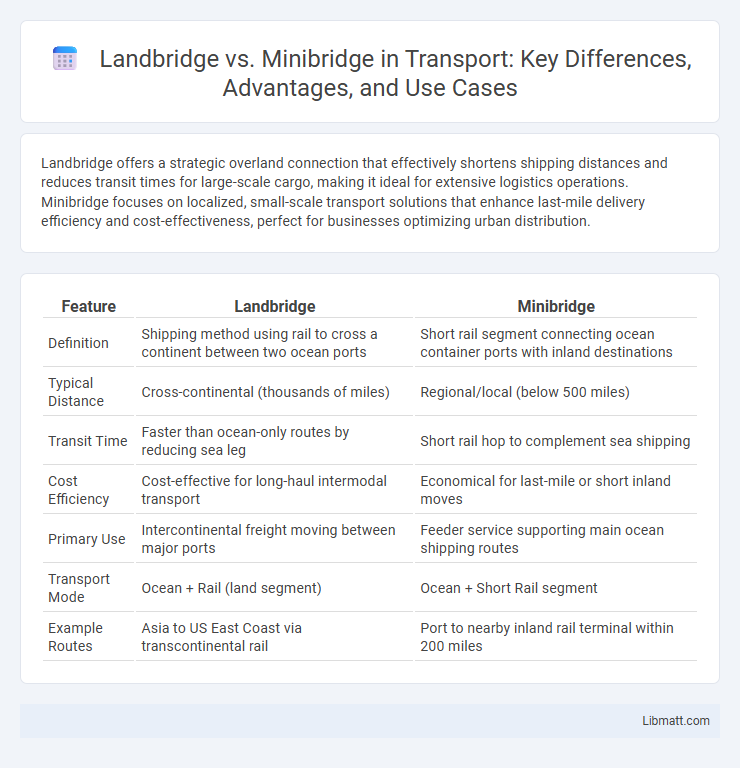Landbridge offers a strategic overland connection that effectively shortens shipping distances and reduces transit times for large-scale cargo, making it ideal for extensive logistics operations. Minibridge focuses on localized, small-scale transport solutions that enhance last-mile delivery efficiency and cost-effectiveness, perfect for businesses optimizing urban distribution.
Table of Comparison
| Feature | Landbridge | Minibridge |
|---|---|---|
| Definition | Shipping method using rail to cross a continent between two ocean ports | Short rail segment connecting ocean container ports with inland destinations |
| Typical Distance | Cross-continental (thousands of miles) | Regional/local (below 500 miles) |
| Transit Time | Faster than ocean-only routes by reducing sea leg | Short rail hop to complement sea shipping |
| Cost Efficiency | Cost-effective for long-haul intermodal transport | Economical for last-mile or short inland moves |
| Primary Use | Intercontinental freight moving between major ports | Feeder service supporting main ocean shipping routes |
| Transport Mode | Ocean + Rail (land segment) | Ocean + Short Rail segment |
| Example Routes | Asia to US East Coast via transcontinental rail | Port to nearby inland rail terminal within 200 miles |
Introduction to Landbridge and Minibridge
Landbridge and Minibridge represent two popular bidding systems in contract bridge, each with distinct strategic approaches and conventions. Landbridge emphasizes natural bidding with an emphasis on precise hand evaluation and constructive bidding, while Minibridge simplifies the auction process by eliminating conventional bidding sequences to focus on hand pattern recognition and straightforward game-level contracts. Both systems aim to improve partnership communication and bidding accuracy, catering to different player preferences and skill levels.
Key Differences Between Landbridge and Minibridge
Landbridge involves transporting cargo containers overland between two ports, typically bypassing congested maritime routes, while minibridge refers to intermodal transport where rail handles the long-haul and road transport covers the first and last mile. Landbridge offers direct, uninterrupted overland transit, enhancing speed and reducing maritime congestion, whereas minibridge optimizes the use of rail for efficiency combined with flexible truck delivery. The primary distinction lies in landbridge's continuous land movement avoiding sea routes versus minibridge's multimodal mix leveraging rail for the main journey and trucks for terminal connections.
How Landbridge Works in Global Logistics
Landbridge in global logistics facilitates efficient cargo transit by transporting goods over land between two seaports, reducing maritime distance and shipping time, especially between Asia and Europe. This method involves moving containers by rail or road across countries like China or Russia, bypassing longer sea routes such as the Suez Canal. The landbridge system enhances supply chain reliability, lowers transportation costs, and supports multimodal logistics integration for faster delivery.
The Role of Minibridge in Container Shipping
Minibridge plays a crucial role in container shipping by enabling faster and more efficient cargo transfers between ships and land transport, reducing port congestion. Unlike traditional landbridge routes that require full overland transit between two seaports, minibridge uses a single port to handle container transshipment, optimizing logistics and cutting transit times. Your supply chain benefits from minibridge through increased flexibility and lower transportation costs, enhancing overall efficiency in global trade networks.
Advantages of Using Landbridge Routes
Landbridge routes offer significant advantages by combining sea and rail transport to shorten transit times between continents, providing faster delivery compared to traditional shipping via the Suez or Panama Canals. This multimodal approach improves reliability and reduces the risk of delays caused by congested waterways or weather disruptions. Using landbridge routes can optimize your supply chain efficiency and reduce overall transportation costs, making them ideal for time-sensitive shipments.
Benefits of Minibridge Operations
Minibridge operations offer significant benefits including easier setup and lower costs compared to traditional landbridge methods, making them ideal for shorter routes and smaller shipments. The use of minibridge reduces transit times by bypassing congested hubs, enhancing supply chain efficiency and reliability. Your logistics can benefit from greater flexibility and simplified coordination, driving faster delivery and improved customer satisfaction.
Cost Comparison: Landbridge vs Minibridge
Landbridge solutions generally incur higher upfront costs due to extensive infrastructure requirements, while minibridge systems are more cost-effective with lower installation and maintenance expenses. Operating expenses for landbridge tend to be higher because of the scale and complexity of their operations compared to the streamlined processes of minibridges. Cost efficiency makes minibridge an attractive option for smaller logistics operations seeking budget-conscious solutions.
Transit Time Analysis: Landbridge vs Minibridge
Landbridge transit time often benefits from faster overland connections between major ports, reducing overall shipping duration compared to traditional sea routes. Minibridge shipments typically experience longer transit times due to additional transshipment points and less frequent service schedules. Choosing the right option depends on your priority between speed and cost efficiency within the supply chain.
Choosing the Right Option: Factors to Consider
When choosing between landbridge and minibridge shipping options, consider factors such as transit time, cost, and cargo type. Landbridge offers faster door-to-door delivery by combining sea and land routes, ideal for time-sensitive shipments, while minibridge leverages direct sea routes to secondary ports, reducing handling costs. Assess your delivery deadlines, budget constraints, and cargo sensitivity to select the most efficient and cost-effective solution for your logistics needs.
Future Trends in Landbridge and Minibridge Logistics
Future trends in landbridge and minibridge logistics emphasize increasing integration of digital technologies like AI and IoT for enhanced route optimization and real-time tracking. You can expect growing investments in sustainable transportation methods, reducing carbon footprints while improving efficiency in freight movement across continents. Emerging markets and evolving trade agreements will drive demand for flexible and scalable logistics solutions, highlighting the importance of agile landbridge and minibridge networks.
landbridge vs minibridge Infographic

 libmatt.com
libmatt.com